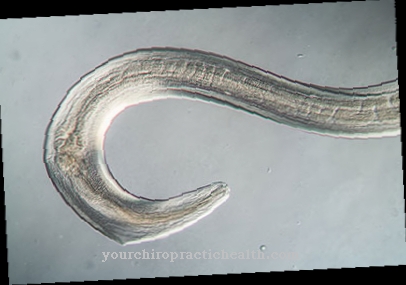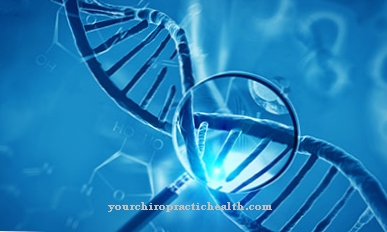The dens is part of the axis, the second cervical vertebra. This consists of a body with vertebral arches and transverse processes and a bone process, the thorn or tooth (dens). When the axis is fractured, the dens is most often affected, which is why this type of fracture is called Dens fracture referred to as.
What is a dens fracture?

© falco47 - stock.adobe.com
A dens fracture is a break in the bone process of the second cervical vertebra. According to the Anderson-D'Alonso classification, three different fracture types are distinguished. Various ligaments attach to the dens axis through which the movement of the cervical vertebrae is passed on to the muscles. One of these ligaments is the transverse ligament.
- In type I fractures, the tip of the dens axis is obliquely broken above this ligament.
- Type II is the most common of the dens fractures. Here the fracture point runs near the base of the dens, close to the transition to the axis body.
- Type III already extends into the body of the axis.
causes
Type I fractures are caused by overstretching the alar ligament. This can happen due to a serious injury with displacement of the head joints between the occiput and the first cervical vertebra. This results in a rupture of the bones of the associated ligaments (ligamenta alaria), which cause the break.
Type II fractures often result from falls. When falling on the face, hyperextension injuries occur, which displace the atlas vertebra backwards; when falling on the back of the head, hyperflexion trauma occurs, which is responsible for a forward displacement of the atlas. In both cases a type II fracture can occur.
In type III, a violent impact causes a vortex displacement. The ligament that surrounds the dens axis (transverse ligament) is massively stretched. If it does not tear during this stretching, the force acting on it is passed on to the vertebra, causing it to break.
The elderly are often affected by fractures of the dens, as the bones of the elderly become increasingly fragile. In younger people, the bone structure is even stronger, which is why they are more likely to injure the ligaments.
Symptoms, ailments & signs
The anamnesis is particularly important here, as the types of injuries depend on the course of the accidents. Injuries such as chin wounds, injuries to the face and head laceration can already indicate an injury in the cervical vertebra area.
If the head and neck are also tilted, with pain and restricted mobility of the upper cervical spine, this indicates even more such an injury. Local tenderness on palpation suggests an upper cervical spine injury as a main symptom. Other symptoms include neck pain, difficulty swallowing, and neurological failures.
diagnosis
The diagnosis is made using imaging techniques. This can be a conventional X-ray examination of the upper cervical spine in three planes, but a computed tomography is more precise. It makes injuries visible or clearer that are often either not recognized or underestimated in the X-ray image.
Complications
The dens fracture can cause complications and pain in various places around the neck. In most cases, however, there are injuries to the cervical vertebrae. The patient suffers from restricted mobility because the movements of the head and neck often lead to pain.
This also greatly reduces the quality of life. There is pain in the neck and throat. These can appear as either resting pain or pressure pain. There are also frequent difficulties in swallowing. It is no longer possible for the patient to carry out sporting or physical activities, which restricts everyday life.
In the worst case, the dens fracture can also paralyze the respiratory center, which can lead to death. Treatment is usually carried out through surgery and the use of a restraint. Depending on the age, this can lead to different further complications, so that another operation may be necessary. Life expectancy is not reduced by the dens fracture if it is treated in good time and the patient is not exposed to any particular stress.
When should you go to the doctor?
Since this complaint is a broken bone, a doctor must be consulted in any case. If the patient does not see a doctor, complications can arise in the further course if the bones do not grow together properly. As a rule, the doctor should be consulted if the patient experiences very severe pain in the neck after an accident or after a blow.
A brief loss of consciousness can also indicate the dens fracture. The dens fracture also leads to significant restrictions in movement and severe swallowing difficulties, making it difficult to take food. A visit to a doctor is definitely necessary even with these complaints. Likewise, severe neck pain can indicate the dens fracture and should therefore be examined. In acute emergencies or in very severe pain, the affected person should go to a hospital or call an emergency doctor. Further treatment is then carried out by immobilizing the affected area.
Doctors & therapists in your area
Treatment & Therapy
The type I fracture is considered stable and can be adequately treated with a cervical brace for one to two weeks. The type II fracture is critical. It is unstable and difficult to treat. There are two treatment routes available. As a conservative therapy, a halo vest is worn for twelve weeks.
The head is held in place by the halo vest and the break can heal. Instead of the halo vest, a cervical orthosis is increasingly being used. Older patients in particular have fewer difficulties with this. What speaks against conservative therapy is that pseudarthroses develop in 35 percent to 85 percent of all cases.
With conservative treatment, there is a risk of pseudarthrosis. The frequency of pseudarthrosis is also given as 35 to 85 percent. Dspseudarthrosis harbors two major dangers. Acute paralysis of the respiratory center with tetraparesis (paralysis of all four limbs) or slowly increasing myelopathy can occur.
In myelopathy, the spinal cord is increasingly damaged by the increasing pressure of the denominational unions. Which can also lead to paralysis and even death. There are also patients with pseudarthrosis who are stable and have no symptoms. With an untreated type II dens fracture, pseudarthrosis occurs in 100 percent of cases.
Since conservative therapy is fraught with many risks, an operation is increasingly being given preference, even in elderly patients. An ideal surgical technique for stabilizing the type II dens fracture has not yet been found. A dorsal screw connection of the cervical vertebrae C1 and C2 (Atlas and Axis) brings the greatest stability, but only a limited movement of the head is possible.
The loss of rotation is 50 percent. In addition, there is a risk of damaging the vertebral artery during the operation and major blood loss during the operation. Another possibility is the anterior dens screw fixation.
There is no loss of rotation here and the patient can be mobilized more quickly, which is particularly important for older patients. However, this leads to higher denial nonunions and up to 20 percent of the cases have to be operated again. An additional ventral screw connection of C1 and C2 can improve stability.
With this fracture, the type of treatment is a matter of weighing up. The decisive therapy goal is the rapid mobilization and reintegration of an old patient. Type III dens fractures are easily treatable conservatively. Pseudarthroses rarely develop here and the patient has to wear a halo fixator or a cervical orthosis for ten to twelve weeks. Surgery is rarely necessary.
Outlook & forecast
In the case of a dens fracture, those affected always need treatment. This disease does not heal itself and in many cases the pain is unbearable, so treatment is definitely necessary.
Those affected suffer from severe mobility restrictions and pain in the neck or head. This can lead to difficulty swallowing, whereby the pain often spreads to the neighboring regions of the body. The patient's quality of life is significantly reduced and restricted by the dens fracture. In the further course it can also lead to neurological failures and furthermore to sensory disorders.
The treatment of the dens fracture always depends on the exact complaints and symptoms and can limit them relatively well. The fracture is straightened through a surgical procedure.The surgical procedure is often no longer carried out in older people, so that they are dependent on conservative therapy. A complete healing cannot be achieved and the movement of the head remains restricted. Dens fracture usually only reduces life expectancy if it has a negative impact on the patient's respiratory function.
prevention
Dens injuries are usually the result of accidents involving the head. Typical for this are traffic accidents or sports accidents, falls while riding and skiing, or jumping into unknown, too shallow waters. A simple fall can be enough for old people.
Only adequate security measures offer protection. Sensible behavior in traffic. A roadworthy car with airbags, properly adjusted neck supports and good seat belts. Observe safety regulations during sport and at work and wear helmets and protective clothing. In the elderly, it is important to treat circulatory problems to prevent fainting and dizziness, which can lead to falls.
Aftercare
A dens fracture is a fracture of the cervical vertebra that often occurs in older people when they fall forward. In order to be able to guarantee an optimal and complication-free course of the disease, regular examinations should be carried out by the treating doctor. Otherwise, there is a risk that this type of fracture will not grow together properly.
If the affected person opts for regular visits to the doctor, then nothing stands in the way of a full recovery. The fracture can be fixed by means of ventral screw connections so that it can grow together firmly and stably. However, appropriate follow-up examinations are of great importance, since such foreign bodies can always cause complications.
If you want to avoid all complications, you should definitely use the follow-up examinations mentioned above. Regular visits to the doctor can ensure a full and timely recovery. However, if the person concerned completely refrains from such follow-up care, serious consequential damage can occur under certain circumstances.
A dens fracture is a disease that should definitely be treated by a doctor and medication. Follow-up exams should also be done for a full recovery to occur. If this does not take place, the person concerned must expect considerable complications or permanent consequential damage.
You can do that yourself
If a dens fracture is suspected, a doctor must diagnose and immediately initiate surgical treatment. After the operation, some self-help measures make everyday life with a dens fracture easier.
This primarily includes rest and bed rest. The back and cervical vertebrae must not be stressed in the first days and weeks after the operation. Further medical examinations are required to rule out neurological damage. If unusual symptoms are noticed, this must be discussed with the responsible doctor.
In addition, physiotherapy and light sport, but also yoga or Pilates are available. Massages help against tension as a result of the splint. Long-term consequences are not to be expected with a dens fracture. Those affected have to be prepared for pain and restricted mobility, especially in the first weeks and months after the accident or fall.
So that the return to everyday life goes smoothly, other people affected should be spoken to. In forums and self-help groups, patients with a dens fracture receive tips on suitable sports, any dietary measures (especially for type II dens fractures) and possible accompanying symptoms. As a result of this and conventional medical treatment, a dens fracture can usually be cured quickly and relatively painlessly.


.jpg)

.jpg)

.jpg)










.jpg)







.jpg)


